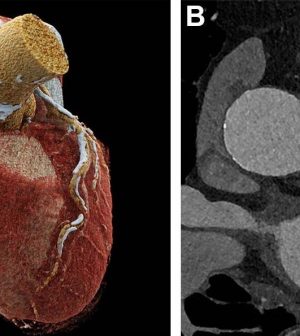- See What Saffron Can Do for Sleep and Heart Health
- 6 Common Mistakes to Avoid Before Your Physical
- Can Sweating Really Help You Beat a Cold?
- Strengthening Your Relationship: Practical Strategies
- Skip Storing This Everyday Product in the Fridge Door
- Green Tea + B3 Pairing May Boost Brain Health
- Navigating Your Midlife Crisis: Embracing New Possibilities
- City Raccoons Showing Signs of Domestication
- Mapping the Exposome: Science Broadens Focus to Environmental Disease Triggers
- One Week Less on Social Media Linked to Better Mental Health
New High-Tech CT Might Expand Heart Imaging

The benefits of noninvasive imaging may soon be available to patients at high risk of coronary artery disease, according to researchers studying a newer technology.
That technology is called ultra-high-resolution coronary CT angiography.
Currently, patients have coronary CT angiography (CCTA), which is highly effective for ruling out coronary artery disease when it’s used in patients who are at low or intermediate risk for the disease.
But those at high risk tend to have a high prevalence of coronary calcifications and stents. These coronary calcifications can “bloom” on CCTA, appearing more extensive than they are. That leads to overestimating blockages and plaque and too many false-positive results, researchers reported in the June 20 issue of the journal Radiology.
“Consequently, patients may undergo unnecessary, often invasive, testing,” said study lead author Dr. Muhammad Hagar, an imaging specialist at the University of Freiburg in Germany. “This is the reason why current guidelines do not recommend using CCTA in high-risk individuals,” he said in a journal news release.
Because the newer technology hasn’t been extensively studied, researchers assessed its diagnostic accuracy and compared it with invasive coronary angiography (ICA), which is the reference standard, in 68 patients.
The study patients had severe cases of a serious valve disease that reduces or blocks blood flow from the heart to the aorta, called aortic valve stenosis.
The ultra-high-resolution technology had an overall image quality score of 1.5 on a 5-point scale where 1 was considered excellent. Nearly 80% of segments were good or excellent.
The technology emits more photons, improving resolution. However, this also increases radiation exposure compared with conventional CT scanners.
“It appears that the spectrum of patients benefiting from undergoing non-invasive CCTA has been significantly broadened by photon-counting detector technology,” Hagar said. “This is excellent news for these patients and the imaging community.”
The technology is at a very early stage. Researchers are developing methods to reduce the amount of radiation exposure, Hagar noted.
“Currently, the technique is feasible for high-risk patients, in whom the benefits outweigh the risks, but should not be applied to all patients referred for cardiac CT imaging,” he said.
The technology could become more prevalent in the next 10 years, he added.
“I am convinced that photon-counting CT is the beginning of a new generation of CT scanners, similar to the introduction to multislice CT 30 years ago,” Hagar said. “For me, these are exciting times.”
More information
The American Heart Association has more on aortic stenosis.
SOURCE: Radiology, news release, June 20, 2023
Source: HealthDay
Copyright © 2025 HealthDay. All rights reserved.










